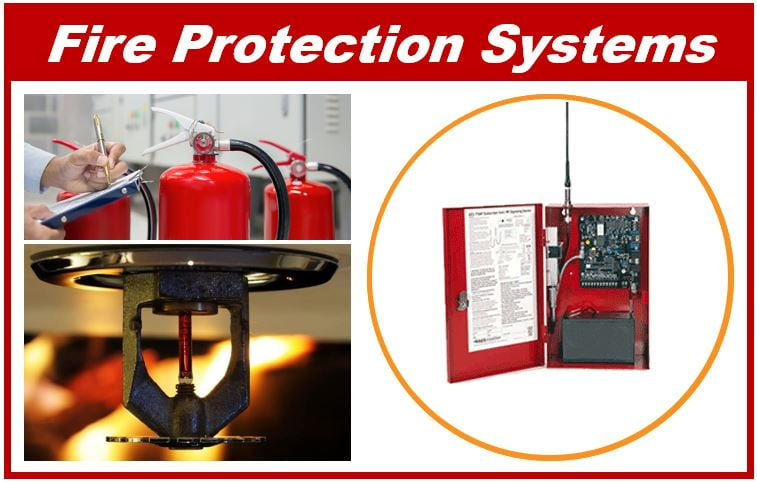Safeguarding your environment from fire outbreaks and consequent damage should be one of your concerns as a home or business owner. This is because fire incidents can spread quickly, damaging property, equipment and costing human lives. While you may be unable to prevent all possible causes of a fire, you can limit the damage done to your building should a fire incident occur.
Fire protection systems provide an avenue for business owners to reduce the damage done to the facility, work equipment, and essential documents. In addition, by detecting and issuing a timely response to fire, these protection systems help to protect the occupants of a building and the equipment within. This consequently helps to save costs and reduce the impact of a fire incident on your business operations.

Fire Protection Systems
As the name implies, fire protection systems (FPS) are designed to detect a fire and protect the human and machinery inside a building in such cases. Thus, they serve as the first line of response during fire hazards.
Although fire protection systems are of various types, their primary function is to secure lives and property from fire damage. In addition, fire protection systems function to give occupants enough time to evacuate and allow firefighters an opportunity to salvage the building from total damage.
There are two categories of FPS, namely passive and active systems. Passive fire protection systems are parts of a building’s structure designed to limit the spread of a fire. This may include compartmentalized fire doors, walls, and cavity barriers. These structures absorb rather than conduct heat and remain tensile in high temperatures, thereby reducing the potential damage of the conflagration.
On the other hand, active fire protection systems are built to combat fires. Examples of active fire protection systems include fire alarms and sprinklers. Fire alarms help notify a building’s occupants of a fire incident, prompting evacuation and emergency responses. Fire sprinklers are triggered by smoke or a predetermined high temperature. Once triggered, the system sprinkles water to suppress and reduce the spread of the fire.
Most residential buildings have installed sprinkler systems, while industrial facilities combine active and passive fire protection systems. Due to the popularity of sprinklers, this article will focus on the types and importance of using them and other fire protection mechanisms.
Types of Sprinklers
When buying or installing sprinklers, recourse must be made to the building structure, residential or commercial status, and the potential levels of fire hazard occurrence. With that out of the way, here are the four major types of sprinklers.
-
Wet Pipe Sprinklers
These are the most common variant of sprinklers due to their affordability. They operate off heat sensors that signal the nearest sprinkler head and release the water stored in the pipes. Sprinkler heads are activated by heat signals only, meaning only those close to the point of the fire get triggered to prevent flooding in cases of false alarms. Wet pipe sprinklers require low maintenance and are ideal for homes, schools, and offices.
-
Dry Pipe Sprinklers
Dry pipe sprinklers function similarly to their wet pipe counterpart. The only difference being that dry pipes are filled with nitrogen and only get filled with water during a fire. They are mostly used in regions with an arctic climate to prevent water from freezing up in the pipes. However, dry pipe sprinklers are more expensive to install.
-
Pre-Action Sprinkler System
This sprinkler system is more advanced than the previously mentioned variants. It operates on a two-factor system that fills the pipes with water upon sensing a predetermined heat level. The final stage of activation occurs in the independent activation of sprinkler heads. The goal of this two-band system is to allow manual overrides where the fire alarm is false. This type of sprinkler is commonly used in libraries, data centers, and museums where water discharge may cause untold damage.
-
Deluge Sprinklers
Unlike the other variants, the deluge sprinkler doesn’t come with a heat sensor; rather, it relies on an external smoke signal to activate. It also has an open sprinkler head, allowing the simultaneous release of water once the pipes get filled with water. This type of sprinkler system is used to combat large fires obtainable in factories working with flammable liquids.
Benefits Of Using Fire Protection Systems
- Fire protection systems help to suppress the spread of the fire. Thereby allowing employees or occupants in a building to evacuate.
- Fire protection systems also safeguard lives and property and reduce the damage done to work equipment.
- An effective combination of passive and active fire protection systems significantly reduces the potential damage your home or business could suffer from a fire incident.
- Fire protection systems are cost-effective, helping you save funds that could have been spent replacing equipment or renovating.
When installing fire protection systems, it is advisable to conduct a Fire Hazard Analysis (FHA) on your building. This identifies the potential fire risks applicable to you and your employees and the best way to limit them. Other relevant factors include the nature of the building and your preferred FPS add-ons – such as notifying emergency services.

